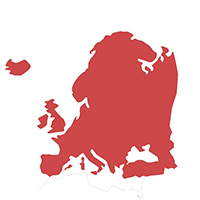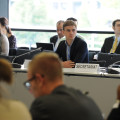Is there room for new players in the international climate regime?
Amy Weinfurter | March 9, 2015.
Close followers of the international climate negotiations are increasingly hopeful that cities, businesses, and cross-sector coalitions will play a significant role in stemming the biggest environmental threat of our time.
Positive signs have begun to appear. Coalitions such as ICLEI’s network of a thousand metropolises, or the alliances of businesses in the Carbon Disclosure Project, are able to act in ways nations can or will not, filling the vacuum left by the international community’s lacklustre efforts.
Major international initiatives are increasingly making room for non-national actors. The UN Climate Summit, convened by Secretary-General Ban Ki-moon in New York last September, merged pledges from world leaders with commitments from leaders within “government, finance, business, and civil society.”
And the United Nations Framework Convention on Climate Change (UNFCCC) is taking notice.
Its Non-state Actor Zone for Climate Action or NAZCA Platform, launched at the 2014 December climate conference in Lima, Peru, showcases some 913 actions, commitments, and initiatives generated by 317 cities, 70 sub-national regions, and 261 companies. A merger of civil society organisations—who contribute and verify the data—and the UNFCCC Secretariat, NAZCA pledges to generate new partnerships and shift the climate conversation towards the “how” of mitigation and adaptation.
The most recent UNFCCC meeting in Geneva, Switzerland last February saw negotiators —particularly from developing nations—echo Mali’s call to look to private, municipal, and regional projects for ways to do “more, faster, now.”
With a landmark meeting coming up in December 2015 in Paris, where the UNFCCC hopes to solidify a new international agreement on climate change for the years beyond 2020, many welcome the new energy and momentum brought by such a solutions-oriented focus.
But despite some positive signals, there are also significant challenges to incorporating sub-national and non-state actors into the future international climate regime.
Hurdles to a more inclusive approach
Some, particularly nation states, worry that incorporating new kinds of actors into the UNFCCC’s architecture might enable countries to duck their commitments—or lead to new kinds of national obligations.
In Geneva, these debates came to a head around the development of Intended Nationally Determined Contributions (INDCs), which will convey national mitigation, adaptation, and financing strategies going into Paris.
Unlike the Kyoto Protocols’ internationally binding emissions requirements, INDCs rely on voluntary target-setting. The jury is still out on whether they will actually cut down on political wrangling over emissions requirements, or simply provide a smokescreen for lower ambition. Their open-ended nature could also enable new kinds of climate actors to participate directly in the UNFCCC process.
But China, along with Brazil, South Africa, and India, has emphasised the need to draw a strong distinction between non-state action and national commitments. Its negotiators argue that non-state actions should not “introduce any new or additional commitments for developing countries and should not replace the mitigation commitments by developed country parties.”
Additional to questions of political will, the attempt to weave non-state and sub-national contributions into INDCs faces gaps in practical know-how. Countries may not be able to determine emissions reductions across such diverse swaths of projects, or to square them with national efforts.
Many businesses, for example, have supply chains that stretch across geographic borders, making it difficult to attribute their carbon reductions to a specific country. Determining whether a city or region’s reductions have already been counted as part of its country’s accomplishments, or represent a truly new source of carbon savings, frequently proves tricky.
And before confronting the challenges of even parsing this data, it first need to be collected. At the moment, initiatives vary widely in their efforts to measure and quantify their impacts.
The Wild West nature of INDC creation could derail new climate actors’ attempts to sync up to national action plans. With just ten months to go before Paris, governments continue to hash out standards for INDC timelines and review. Without concrete information about the structure of states’ efforts, non- and sub-state actors will struggle to create projects and metrics that complement them.
Any attempts to verify national and sub- and non-state efforts must walk a fine line, gathering information without discouraging participation. Businesses, for instance, can play critical roles in reducing emissions, but may balk at monitoring costs or increased public scrutiny.
It remains to be seen if the INDC framework will morph into a productive feedback loop, or trip as it tries to incorporate new kinds of climate responses.
Geneva made strides towards identifying crucial questions about the INDC framework for moving in this direction. The release of the first INDCs occurs this March, and the next UNFCCC meeting in June, will test the international community’s ability to deliver them.













comment